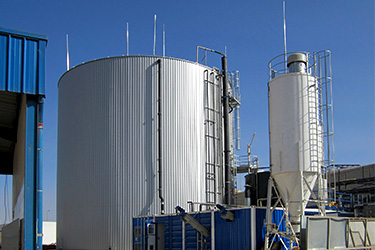Anaerobic Processes
-
ABR Process
An anaerobic baffled reactor (ABR) is an improved Septic Tank with a series of baffles under which the grey-, black- or the industrial wastewater is forced to flow under and offer the baffles from the inlet to the outlet. The increased contact time with the active biomass (sludge) results in improved treatment. ABRs are robust and can treat a wide range of wastewater, but both remaining sludge and effluents still need further treatment in order to be reused or discharged properly.The upflow chambers provide enhanced removal and digestion of organic matter. BOD may be reduced by up to 90%, which is far superior to its removal in a conventional Septic Tank.
-
EGSB
An expanded granular sludge bed (EGSB) reactor is a variant of the upflow anaerobic sludge blanket digestion (UASB) concept for anaerobic wastewater treatment.The distinguishing feature is that a faster rate of upward-flow velocity is designed for the wastewater passing through the sludge bed. The increased flux permits partial expansion (fluidisation) of the granular sludge bed, improving wastewater-sludge contact as well as enhancing segregation of small inactive suspended particle from the sludge bed. The increased flow velocity is either accomplished by utilizing tall reactors, or by incorporating an effluent recycle (or both).
The EGSB design is appropriate for low strength soluble wastewaters (less than 1 to 2 g soluble COD/l) or for wastewaters that contain inert or poorly biodegradable suspended particles which should not be allowed to accumulate in the sludge bed.
- IC
The internal circulation reactor (IC reactor) is a form of anaerobic digester. It is primarily designed to treat wastewater. The IC reactor is an evolution of the UASB and EGSB digestion systems. The digester typically produces biogas with a high concentration methane (c80%). In essence the IC to improve digestion rates and gas yields. The foot print for the IC reactor is therefore typically smaller however it is taller due to the increased complexity of the reactor.
The IC reactor typically comes as part of a two-stage anaerobic digestion system where it is preceded by an acidification and hydrolysis tank. Effluent leaving the IC reactor will often require aerobic treatment to reduce biochemical (BOD) and COD to discharge consent levels.
-
UASB Process
The upflow anaerobic sludge blanket reactor (UASB) is a single tank process in an anaerobic centralised or decentralised industrial wastewater or blackwater treatment system achieving high removal of organic pollutants. Wastewater enters the reactor from the bottom, and flows upward. A suspended sludge blanket filters and treats the wastewater as the wastewater flows through it. Bacteria living in the sludge break down organic matter by anaerobic digestion, transforming it into biogas. Solids are also retained by a filtration effect of the blanket. The upflow regime and the motion of the gas bubbles allow mixing without mechanical assistance. Baffles at the top of the reactor allow gases to escape and prevent an outflow of the sludge blanket. As all aerobic treatments, UASB require a post-treatment to remove pathogens, but due to a low removal of nutrients, the effluent water as well as the stabilised sludge can be used in agriculture.

Biofilm Reactor
- BAS
BAS combination process is a biological treatment process that combines the very best from activated sludge and biofilm technologies. Careful design of process stages yields an optimal activated sludge stage and a MBBR biofilm stage that is robust towards peak and shock contaminant loading conditions. The result is consistently high and reliable treatment efficiency of any type of industrial wastewater.
The initial MBBR biofilm unit process shaves the loadings peaks and any toxic inhibition effects while removing 50 to 70 percent of the incoming BOD. This pretreatment achieves 2 to 3 times increased capacity compared to a traditional activated sludge process while also being more compact. Furthermore, the BAS™ combination process improves activated sludge characteristics making the activated sludge stage more inherently stable with a waste sludge that is easier to dewater.
-
FBBR
FBBR (Fluidized Bed Bio Reactor) Sewage Treatment Plant ensures better quality of treated sewage. The FBBR media used is manufactured out of UV stabilized polypropylene. Due to the FBBR technology integrated in the sewage treatment plant, the enitre cost for installation and hyddraulic renetion time beocmes quite low. This type of sewage plant is speically developed and isntalled for reprocessing the water so that it can further used for several purposes like irrigation, gardening, vehicle washing and flushing.
- Lagoon Guard
Aerated lagoons are used extensively in many areas for treatment of both municipal and industrial wastewater. In North America there are thousands of larger lagoons treating municipal wastewater. These systems can adequately remove COD and BOD but nitrification is not readily accomplished giving poor nitrogen removal.
As municipalities with aerated lagoons are increasingly required to limit the release of ammonium to receiving waters they are facing the hard choice of whether to build an expensive completely new process or to somehow upgrade the lagoon in order to obtain nitrification.
The LagoonGuard biofilm process entails a well designed supplementary MBBR biofilm process after the lagoon which will handle the ammonium and may even provide some additional COD removal. The upgrade is easy and economical, compact and, in the spirit of the lagoon itself, the LagoonGuard biofilm process upgrade requires a minimum level of maintenance.
The LagoonGuard biofilm process is a result of our research in the area of MBBR biofilm technologies for advanced wastewater treatment process.
- MBBR
In the MBBR biofilm technology, the biofilm grows protected within engineered plastic carriers, which are carefully designed with high internal surface area. These biofilm carriers are suspended and thoroughly mixed throughout the water phase. With this technology, it is possible to handle extremely high loading conditions without any problems of clogging, and treat industrial and municipal wastewater within a relatively small footprint.
The MBBR biofilm technology is efficient, compact and easy to operate. It can be an excellent solution as a stand-alone process, a Moving Bed biofilm reactor, or it can be used to specifically enhance or upgrade treatment potential of activated sludge processes.
The MBBR can be used as sole biological treatment or in combination with other technologies. It works well together with chemical treatment. When operated at low organic loading and as a multi-step process, a unique microflora is developed in each step and this will significantly increase the possibility for removal of both easily degradable organic matter and more hard-to-degrade organic matter in the different steps.

ENR Process
-
BABE
The BioAugmentation Batch Enhanced (BABE) process is comprised of a single batch reactor. Side stream waters high in ammonia content and return activated sludge (RAS) from the main biological treatment process are combined.with previously settled sludge in the batch reactor. The RAS is used to augment the bacteria in the settled sludge. By utilizing a batch reactor, the long residence times necessary to grow both the nitrifying and denitrifying bacteria are possible. There are five phases to the BABE process: 1) filling,2) mixing and aeration, 3) mixing, 4)settling, and 5) settling and decant . The first two steps are done under aerobic conditions. The third involves mixing without aeration to achieve anoxic conditions.
- Canon
The CANON system (Completely Autotrophic Nitrogen Removal Over Nitrite) can potentially remove ammonium from wastewater in a single, oxygen-limited treatment step. The usefulness of CANON as an industrial process will be determined by the ability of the system to recover from major disturbances in feed composition. The CANON process relies on the stable interaction between only two bacterial populations: Nitrosomonas-like aerobic and Planctomycete-like anaerobic ammonium oxidising bacteria. The effect of extended periods of ammonium limitation was investigated at the laboratory scale in two different reactor types (sequencing batch reactor and chemostat). The lower limit of effective and stable nitrogen removal to dinitrogen gas in the CANON system was 0.1 kg N m(-3) day(-1). At this loading rate, 92% of the total nitrogen was removed.
-
HF-MBfR
The Hollow-Fiber Membrane-Biofilm Reactor (HFMBfR) is the optimal environment for bringing together the oxidized contaminant, the capable bacteria, and H2 as the electron donor. The HFMBfR is different from membrane bioreactors (MBRs) used to treat wastewaters. HFMBR was developed to remove nitrate from contaminated drinking water using molecular hydrogen as a clean electron-donor substrate. The hollow fibers were sealed on one end and were pressurized with hydrogen on the other end.
In the HFMBfR, H2 gas diffuses through the wall of a composite membrane, and an autotrophic biofilm naturally develops on the outside of the membrane, where the bacteria’s electron acceptor is an oxidized contaminant (e.g., NO3 – or ClO4 – ) supplied from the water. The hydrogen pressure to the hollow fibers is a key control parameter that can be adjusted rapidly and easily. For denitrification, partial nitrate removal often is acceptable, and the hydrogen pressure can be low to minimize the costs of H2 supply and the concentration of H2 in the effluent.
-
INNITRI
InNitri (Inexpensive Nitrification) is a new, side stream nitrification process Technologies, Inc. It allows nitrification at short SRT values, even at low winter temperatures and provides nitrification in a substantially smaller aeration tank than is required for conventional nitrification design. The InNitri process was developed to provide an inexpensive alternative for plants in northern climates that need to upgrade their air or pure oxygen activated sludge process for year-round nitrogen removal.
In general, the InNitri process consists of supplemental nitrifiers being added constantly to the main activated sludge process to replenish nitrifiers removed with the wasted activated sludge. The supplemental nitrifiers are grown in a separate, small, side-stream aeration tank using either ammonia available in the digested sludge dewatering liquid and in th supernatant or commercial ammonia.
-
OLAND
Ammonia gas is conventionally treated in nitrifying biofilters; however, addition of organic carbon to perform post-denitrification is required to obtain total nitrogen removal. Oxygen-limited autotrophic nitrification/denitrification (OLAND), applied in full-scale for wastewater treatment, can offer a cost-effective alternative for gas treatment.
-
Sharon Anammox
The ANaerobic AMMonium Oxidation (ANAMMOX) process is a variation on the SHARON process described previously. In the ANAMMOX process, ammonium is converted to dinitrogen gas (N2). The combination of the SHARON process with the ANAMMOX provides an efficient and cost effective treat nutrient rich side streams.
Treatment step 1: SHARON
process. The SHARON process is used to produce an ammonium-nitrite mixture. For the SHARON/ ANAMMOX process however, the goal is to convert only 50 percent of the ammonium to nitrite so the difference in the SHARON portion of this process is the conversion of only 50 percent of the ammonium. To ens only 50 percent of the ammonium is con to nitrite, the oxygen supply is limited.
Treatment step 2: ANAMMOX process.
In this treatment step, the ammonium-nitrite mixture produced in the SHARON reactor is converted to nitrogen gas. Ammonium is used as an electron donor under anoxic conditions. The conversion of amm nitrogen gas is described by the following formula :
NH4+ + 1.5 O2 ⇒ NO2– + H2O + 2 H+
The bacteria involved in the reaction are autotrophic do not need the addition of an external carbon source.
Since the ANAMMOX bacteria have a slow growth rate (doubling in 10 days at 30°C) , sufficient volume must be available to prevent wash out of the bacteria.

